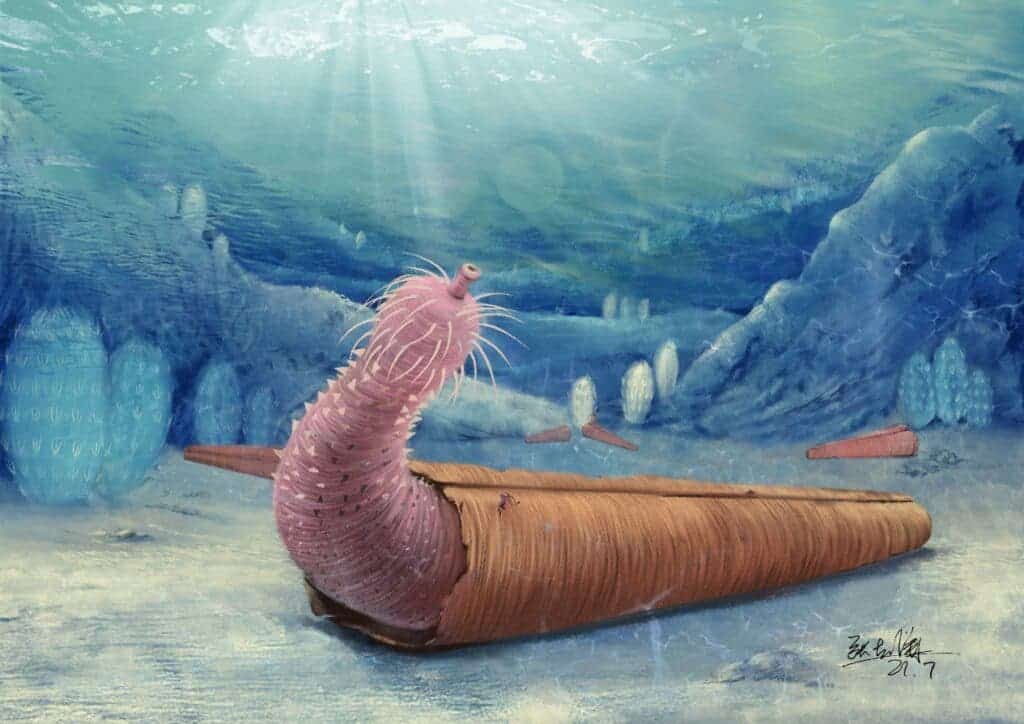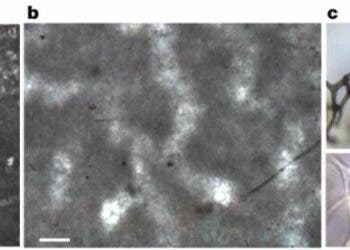The “hermit” lifestyle best known from crabs today was first invented 500 million years ago by worms, new research reveals.

Hermit crabs today are famous for seeking out and taking residence in discarded snail shells. This offers the animals protection against predators while allowing them to avoid the huge energy and nutrient costs associated with building such a shell from scratch. It’s quite an effective strategy for the crabs.
However, they’re not the ones to first think of it. Researchers at Durham University and Yunnan University report that penis worms (phylum Priapulida) were busy taking up residence in discarded shells during the Cambrian period some 500 million years ago. This is the oldest known evidence of the ‘hermit’ lifestyle that we’ve found so far, the team adds.
Renting a place
“Priapulan-like worms were very common in the Cambrian, sometimes forming shallow burrows but often moving along the surface of the sea bed,” said Dr. Martin R. Smith, an Associate Professor in Palaeontology at Durham University and a co-author of the paper, in an email for ZME Science. “Some had little defensive plates or built their own tubes for protection from predators; others even had little claw-like hooks on their underside to help them move about.”
“Today, priapulans are only found in hard-to-inhabit places, such as those with low oxygen, or miniaturized between sand grains — places where predators find it hard to make a living. We used to think that predators struggled a bit in the Cambrian too, but clearly — at least in the Guanshan [area, where these worm fossils vere recovered] — predators were enough of a threat to make priapulans reach for a more ‘modern’ style of defensive mechanism!”
Fossil deposits in the Guanshan, an urbanized area in southeastern Taiwan. The fossil deposits in this area are famous for often preserving soft tissue alongside harder material such as shells, which is quite rare for fossils. Four specimens of penis worms in the genus Eximipriapulus from this area were recovered inside the conical shells of hyoliths, another group of long-extinct animals.
“The worms are always sitting snugly within these same types of shells, in the same position and orientation. My first thought was ‘can I be sure that this isn’t a coincidence’, so we had to look hard at the fossils to be sure that the worms were in (rather than on or below) the shells, that the relationship was consistent, etc.,” explains Dr. Smith for ZME Science.
The findings cast new light on our understanding of the ecosystem relationships during the Cambrian. This was a geological period that was a hotbed of evolution, with many and exotic forms of life appearing all over the planet. The rapid evolutionary changes during this time have earned it the nickname of the “Cambrian explosion”. And some very peculiar lifeforms appeared during this time; in many ways, life on Earth during the Cambrian was quite alien-looking.
It was definitely a valuable time in history. The trial-and-error that happened during this time led to the emergence of what we’d call ‘the modern’ animal body.
But more to the point, the high rates of diversification during the Cambrian led to the emergence of predators in many environments where they were completely lacking before. This, in turn, led to an arms race between predator and prey that still continues to this day.
“The only explanation that made sense was that these shells were their homes – something that came as a real surprise,” Dr Smith adds in a press release. “Not long before these organisms existed, there was nothing alive more complex than seaweeds or jellyfish: so it’s mind-boggling that we start to see the complex and dangerous ecologies usually associated with much younger geological periods so soon after the first complex animals arrive on the scene.”
Hermit crabs today take permanent residence in the shells they find laying on the sea bottom, carrying them around on their backs. The team believes penis worms also carried hyolith shells around, that they “likely dragged the shells with them”, Dr. Smith told me.
“We believe that they dwelt in them permanently (except to up-size when they grew). It’d be lovely to see trace fossils showing the grooves made by dragging the shells, but as the fossils were transported to their resting place, we don’t have definitive evidence,” he told ZME Science.
Hermit crabs today eventually outgrow their shells. Groups of hermit crabs looking for an upgrade will often get together and line up from smallest to largest, then trade shells among themselves. It’s a pretty handy way to make sure that everybody has at least a shell, and that most crabs have a proper shell to live in (some, sadly, are left with shells that are a bit too tiny or defective in some way). I asked Dr. Smith whether there’s any sign that the worms engaged in similar social behavior to find shells to inhabit.
“No evidence, and there seems to have been no shortage of shells in this environment, so it probably didn’t happen in Guanshan – but we don’t have evidence to say either way,” he explaned for ZME Science. “I’d be surprised if they did, as this ‘feels’ like a sophisticated behaviour for this group, and for the Cambrian period – but then I would have said that about hermiting at all before I saw these fossils!”
Despite their hermiting lifestyle, penis worms were not helpless beasts in their ecosystems. Dr. Smith tells me that shells from brachiopods (lamp shells), trilobites, and hyoliths have been found in the guts of penis worms related to the ones the team investigated here.
“Worth mentioning that ecologically, priapulans were both predators and prey; many fed on organic material within mud, but others scavenged and some may have been active predators themselves,” he told ZME Science.
The findings are valuable as they represent the earliest known case of an animal engaging in a hermit lifestyle. It gives us context to better understand the ecosystem dynamics of the Cambrian period, and of the emergence of wide-scale predation on Earth.
The paper “A ‘hermit’ shell-dwelling lifestyle in a Cambrian priapulan worm” has been published in the journal Current Biology.






